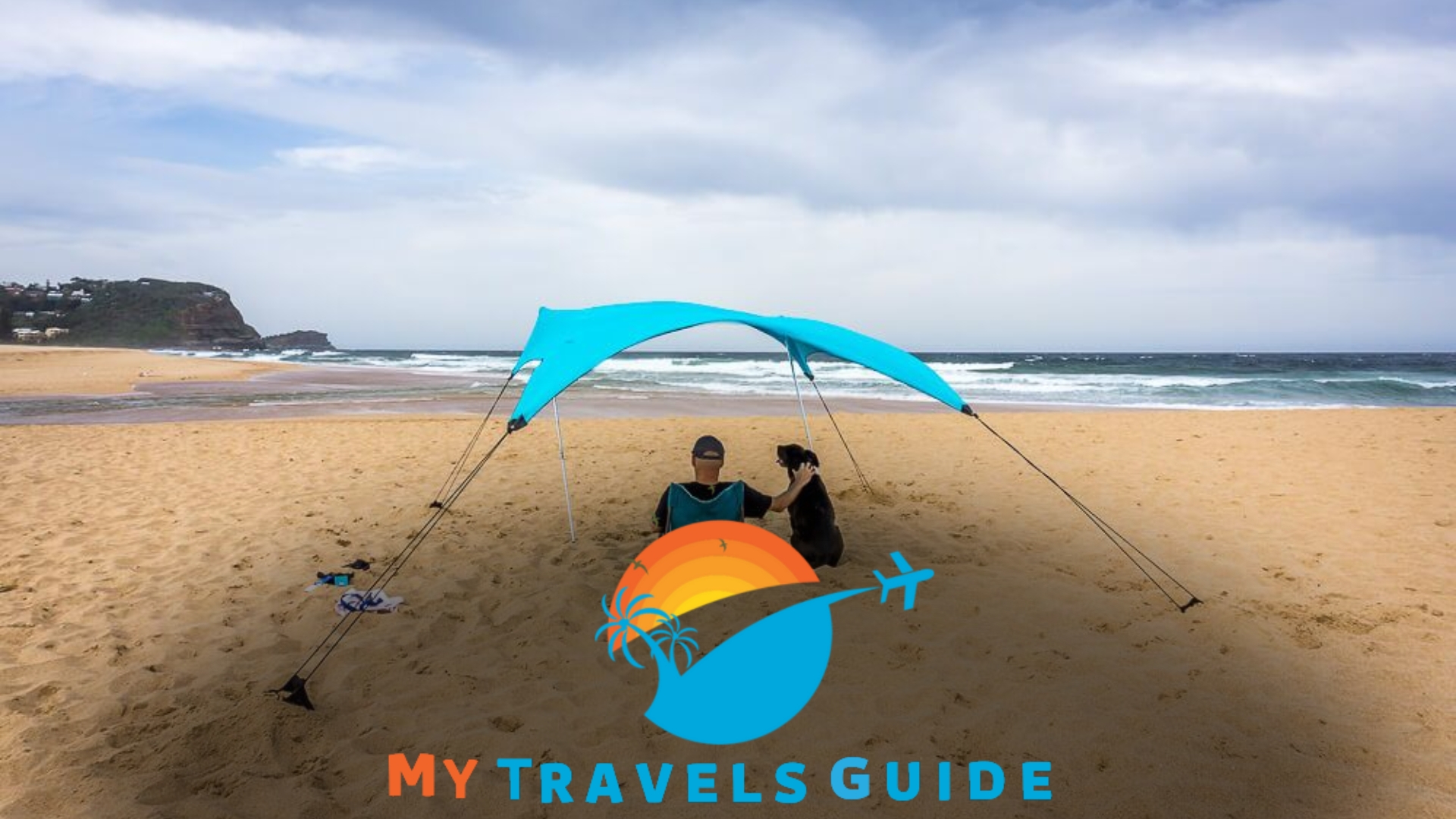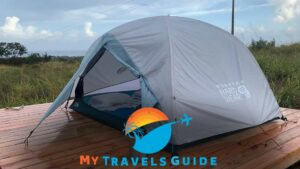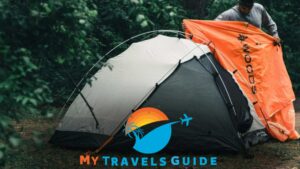In this article:
When it comes to outdoor adventures, having a waterproof tent is essential for a comfortable and dry camping experience.
In this article, we will explore the best waterproofing methods for tents and their pros, cons, features, and overall effectiveness. We’ll help you decide to keep your shelter protected from the elements. Let’s dive in!
Camping enthusiasts know the importance of a waterproof tent. No one wants to wake up in a wet and soggy shelter due to unexpected rain or moisture.
Waterproofing your tent is a proactive step that ensures you stay dry and cozy, regardless of the weather conditions.
Importance of Waterproofing for Tents
Waterproofing your tent is crucial because it creates a barrier that prevents water from seeping into the fabric. Rain, snow, or even morning dew can compromise the integrity of your tent, making it uncomfortable and less durable.
Applying a waterproofing method protects yourself and your gear from the discomfort and potential damage caused by moisture.
Types of Waterproofing
There are several effective waterproofing methods available for tents. Let’s explore some of the best options along with their pros and cons:
Polyurethane (PU) Coating

Polyurethane (PU) coating is a type of polymer applied to the surface of a material, often fabric, to enhance its properties. It’s also known as “poly-coating”.
PU coating is used in the pharmaceutical, diaper, activewear, and pet industries. It also manufactures appliances, military equipment, construction materials, and more.
PU coating provides several benefits. It makes fabrics more lightweight, water-resistant, and flexible. It also enhances the hardness, flexibility, and adhesion of the material it’s applied to.
PU coatings resist extreme temperatures, water, oil, grease, and chemicals. They also exhibit good electrical insulating properties and have a wide resilience range.
In terms of appearance, PU coatings can be shiny, opaque, transparent, or muted. They are also customizable and can adhere to many surfaces and materials.
PU coatings are more robust and resistant to tears, kinks, and abrasion than uncoated materials. They are also resistant to mold, mildew, and fungus, making them suitable for tropical environments.
However, PU coatings have some limitations. They are flammable and adhere weakly to metal substrates. They can also weaken if exposed to direct sunlight for extended periods.
Despite these drawbacks, PU coatings are still widely used due to their versatility and the protection they offer to the materials they are applied to.
Compared to other coatings like silicone, PU is stronger and does not puncture easily. It also does not attract dirt like silicone coatings, which can lead to a gradual build-up that makes the coating system more susceptible to damage.
In terms of environmental impact, PU coating is considered a greener option as it does not create dioxins. However, the solvent type of PU coating has certain toxicity and flammability and is not environmentally friendly.
Pros
- Polyurethane coating is popular due to its affordability and good water resistance. It forms a thin, flexible film that prevents water from penetrating the tent fabric.
Cons
- PU coatings can deteriorate over time and may require reapplication. They may also decrease the breathability of the tent, leading to condensation in humid conditions.
Silicone Coating

Due to its unique properties, silicone coating is a versatile material used in various applications. It is chemically inert, nonstick, and hydrophobic, making it an excellent material for waterproofing fabrics such as tents.
Silicone coatings are also used in the roofing industry due to their resistance to ponding water, UV protection, flexibility, and high solids content.
In the context of tents, silicone coatings are applied to both sides of the fabric, creating a waterproof barrier. This is often referred to as sil/sil fabric.
Silicone is more inert than polyurethanes, making it less prone to react with other compounds, which is why it’s safe for use in cooking tools or internal implants.
In the roofing industry, silicone coatings are popular due to their resistance to ponding water and UV radiation. They can reflect up to 80-90% of the sun’s harmful UV rays, resulting in significant energy savings.
Silicone roof coatings are also environmentally friendly, especially high-solids formulations, which are typically solvent-free and contain extremely low volatile organic compounds (VOCs).
Silicone roof coatings can be applied directly to the existing roofing surface with only a power washing, resulting in lower labor and material costs as no primer is needed. They can be applied by rolling or spraying and cure faster than many other coatings.
However, there are some drawbacks to silicone coatings. They can make surfaces very slippery when wet, which can be a safety hazard, especially on roofs. While silicone coatings are durable, they can’t stand up to tearing.
In terms of maintenance, silicone-treated fabrics and roofs must be cleaned regularly to maintain performance. For tents, a silicone sealant can keep moisture out and seal seams.
For roofs, regular power washing and professional maintenance are recommended.
Pros
- Silicone coatings provide superior waterproofing performance and excellent durability. They create a highly water-repellent layer that can withstand heavy rainfall.
Cons
- Silicone coatings are typically more expensive than PU coatings. They may also add weight to the tent and reduce breathability.
Seam Sealing

Seam sealing is a process used to waterproof the seams of outdoor gear, such as tents, tarps, and awnings, to prevent moisture from seeping through the holes created by stitching.
This process is crucial for maintaining comfort and dryness in outdoor settings, especially during rainy conditions.
Seam sealers are typically made from durable materials like urethane or silicone, which bond permanently to various fabrics, including nylon, vinyl, polyester, and silicone-treated fabrics.
They provide a water-tight seal that won’t peel or crack over time and can flex with the gear. Some sealers, like Seam Grip+WP and Seam Grip+SIL, are specifically designed for different types of fabrics.
For instance, Seam Grip+SIL is the only sealer that adheres to silicone-impregnated or silicone-coated fabrics.
To seam seal a tent, you’ll need a seam sealer suitable for your tent’s fabric, a rag, and rubbing alcohol. The process involves setting up the tent in a dry, sunny spot or brightly lit room, cleaning the seams with a rag and rubbing alcohol, and then applying the seam sealer.
Sealing seams on the underside of the fly and the inner side of the tent body is recommended. After application, the sealer needs to dry completely.
Seam sealing not only waterproofs your gear but can also repair pinhole rips in the fabric. Applying a small amount of sealer over the hole can prevent it from leaking.
However, it’s important to note that the type of sealer used should match the fabric of your gear. For example, silicone sealers should be used on silicone-treated fabrics, while urethane-based sealers are suitable for other fabrics.
While many tents from larger companies come already seam sealed, it’s good practice to inspect them for wear, such as peeling tape routinely. After a few seasons of hard use, it’s almost guaranteed that the seams will need to be resealed.
Pros
- Seam sealing is an additional step that reinforces the waterproofing of a tent. It prevents water from seeping through the stitched seams, offering extra protection.
Cons
- Seam sealing requires careful application and periodic reapplication, especially in areas of high stress or wear.
Durable Water Repellent (DWR) Treatment

Durable Water Repellent (DWR) is a coating applied to fabrics to make them water-resistant (hydrophobic).
This treatment is essential for maintaining outdoor gear performance, especially rainwear, as it helps water to bead up and roll off the fabric surface, preventing the material from becoming saturated and heavy.
DWR treatments use waterproof, breathable fabrics like GORE-TEX to enhance their effectiveness.
Over time, DWR coatings can wear off or become less effective due to dirt, body oils, and other contaminants. When this happens, the fabric may “wet out,” reducing breathability and the garment’s ability to repel water.
To maintain the functionality of DWR-treated gear, it’s important to clean and reapply the DWR treatment periodically.
Pros
- DWR treatment enhances the water resistance of the tent fabric by causing water to bead and roll off the surface. It complements other waterproofing methods and improves overall performance.
Cons
- DWR treatment may wear off over time and require reapplication. It is less effective in heavy rain compared to other waterproofing methods.
Choosing the Best Waterproofing Method
When selecting a waterproofing method for your tent, consider the following factors:
- Effectiveness: Choose a method known for keeping water out and maintaining the tent’s dryness.
- Durability: Look for a waterproofing method that offers long-lasting protection, reducing the need for frequent reapplication.
- Breathability: Ensure that the method allows moisture to escape from the tent, preventing condensation and maintaining airflow.
- Ease of Application: Consider your skills and comfort level with applying the chosen waterproofing method. Some methods are easier to apply than others.
- Compatibility: Check if the waterproofing method suits your tent’s fabric and complements existing treatments or coatings.
Top Waterproofing Products for Tents
Here are some popular waterproofing products for tents known for their effectiveness and features:
1. Nikwax Tent & Gear SolarProof

Nikwax Tent & Gear SolarProof is a waterproofing treatment designed to protect outdoor gear from water and UV damage. It suits all weatherproof textiles, including tents, backpacks, awnings, and covers.
The product works by adding Durable Water Repellency (DWR) to the maximum testable standard and ultraviolet (UV) protection to inhibit the reduction of fabric tear strength caused by UV rays.
This dual protection can potentially double the effective life of your gear.
Nikwax Tent & Gear SolarProof is easy to apply by hand. The gear should first be cleaned with Nikwax Tent & Gear SolarWash for best results.
The SolarProof product should then be sprayed evenly onto the outside of the fabric. After waiting for 2 minutes, any surplus product should be removed with a damp cloth.
The product should be applied to all areas of the gear to ensure no areas have been missed.
The product is safe to use, being water-based, non-aerosol, non-flammable, non-hazardous, and environmentally friendly. It contains no harmful solvents or volatile organic compounds (VOCs) and is completely fluorocarbon-free.
Nikwax Tent & Gear SolarProof is available in different sizes, including a 16.9 fluid ounces bottle. Users have reported positive experiences with the product, noting its effectiveness in waterproofing and UV protection.
Pros
- Nikwax Tent & Gear SolarProof is a water-based waterproofing spray that offers UV protection. It rejuvenates the DWR treatment, increases water repellency, and protects against sun damage.
Cons
- Requires reapplication every six months for optimal performance.
2. Gear Aid Seam Grip WP

Gear Aid Seam Grip WP is a waterproof sealant and adhesive designed for seam sealing and repairing outdoor gear such as tents, tarps, awnings, and more.
It is a clear, urethane-based product that bonds permanently to various materials, including nylon, vinyl, leather, and polyester.
The product is known for its durability, flexibility, and abrasion resistance. It cures to a thin rubber seal that flexes with high-performance gear, providing a water-tight seal that won’t peel or crack over time.
It can seal up to 3.66 meters of tents, tarps, and awnings with a 28g tube.
In addition to sealing seams, Gear Aid Seam Grip WP can patch up holes in all fabric types, making it a versatile tool for gear repair. It has won the prestigious Backpacker Magazine’s Editors’ Choice Gold Award for its effectiveness in waterproofing gear.
To use Gear Aid Seam Grip WP, apply it to the seams or areas needing repair, then allow it to cure. The product dries in 24 hours and is fully cured in 72 hours. Applying it to a clean and dry surface is recommended for optimal results.
Gear Aid also offers a Seam Grip WP Field Repair Kit, which includes the waterproof sealant and two peel-and-stick patches for on-the-go repairs.
Pros
- Gear Aid Seam Grip WP is a seam sealer that provides long-lasting protection against water intrusion. It works on various fabrics and is flexible even in low temperatures
Cons
- Requires proper application and drying time. It may leave a noticeable film on some tent fabrics.
3. Atsko Silicone Water-Guard

Atsko Silicone Water-Guard is a waterproofing treatment designed for various materials, including outerwear, footwear, tents, sleeping bags, and suede.
It is formulated to provide maximum repellency with a single application and is known for restoring factory waterproofing while still allowing materials to breathe.
The product repels water and stains and is suitable for use on items made from natural and artificial fibers such as nylon, polyester, and blends.
The product dries in 24 hours and is fully cured in 72 hours, after which it becomes odorless. It is also noted for its ability to resist salt stains and for containing cross-linking polymers, which are touted as the highest quality water-repellent.
Additionally, Atsko Silicone Water-Guard is safe for Gore-Tex-lined outerwear and footwear.
When using Atsko Silicone Water Guard, applying it to a clean and dry surface is important. The container should be held vertically, about 15 to 20 cm from the material, and sprayed until the surface is uniformly moist.
Only one application is recommended for optimal effect. The product also offers some sun protection and mold/mildew resistance.
Users have reported positive experiences with Atsko Silicone Water-Guard, stating that it works great and that they appreciate the high quality of the product. It is made in the USA and is available in different sizes, including a 10.5 oz aerosol can.
Pros
- Atsko Silicone Water-Guard is a silicone-based waterproofing spray that provides excellent water repellency and protects against stains. It is suitable for a wide range of outdoor gear, including tents.
Cons
- Due to its strong odor, the application process may require more effort and ventilation.
Step-by-Step Guide to Waterproofing a Tent
Waterproofing a tent involves several steps, including cleaning the tent, sealing the seams, refreshing the urethane coating, and applying a durable water repellent (DWR). Here’s a step-by-step guide:
- Clean the Tent: Start by cleaning your tent thoroughly. Remove any dirt or stains that can damage the tent. You can use a non-abrasive sponge and mild liquid soap for this process.
- Seal the Seams: The tent’s seams are common areas where water can seep. To seal them, you’ll need a seam sealer suitable for your tent’s fabric (silicone-treated fabric and polyurethane-coated fabrics require different sealers). Apply the sealer on each seam using a brush or popsicle stick, then wipe off the excess with a clean cloth or rag and let it dry.
- Refresh the Urethane Coating: The urethane coating on the inside of your rainfly and the floor of your tent are the primary barriers against water. Over time, this coating can wear out and need refreshing. First, cover the floor with plastic and tape it down to prevent water seepage. Then, let the urethane dry and apply a second layer to ensure water is repelled.
- Apply a Durable Water Repellent (DWR): A DWR coating helps your rainfly shed water. Products like NikWax or Revivex can be used for this process. Apply the DWR evenly on your clean, damp tent and allow it to dry.
Remember, it’s best to waterproof your tent every 1-3 years, depending on usage, to prolong its life and ensure it remains effective against the elements.
Maintenance and Reapplication
Maintaining and reapplying waterproofing to your tent is essential to tent care. Over time, the waterproof coating on a tent can degrade, leading to potential leaks.
There are three main ways to waterproof your tent: sealing the seams, refreshing the urethane coating, and refreshing the Durable Water Repellent (DWR) coating.
Sealing the seams involves applying a seam sealer to prevent moisture from seeping through. The type of sealer you use depends on the fabric of your tent.
Most tents use polyurethane-coated fabrics, but silicone-treated fabric requires a different sealer.
Refreshing the urethane coating involves applying a new coating to the inside of your rainfly and the floor of your tent. This coating is the primary defense against water.
Refreshing the DWR on a tent involves applying a spray-on water-repellent product. If rain isn’t beading up on your fly anymore, it’s a sign that the DWR coating is beginning to fail and may need to be reapplied.
The ideal time to reproof a tent is in the spring, at the start of the camping season. A tent should be reproofed every 12-24 months, depending on its usage. If it is used up to three weeks per year, reproofing every 24 months should suffice.
When reproofing your tent, it’s important to do so on a clear, dry, warm day. The tent should be pitched in an outdoor setting with plenty of ventilation.
After applying the waterproofing agent, use a clean cloth to wipe away any drips or excess waterproofing, and then allow the tent to dry.
It’s also important to clean your tent properly before applying any waterproofing treatments. Avoid household cleaners such as harsh dish soaps, bleach, spot removers, or laundry presoaking products, as these can impair a tent’s DWR coating.
Instead, gently scrub soiled areas by hand using a non-abrasive sponge, cold water, and a non-detergent soap.
Remember, if you must pack up your tent in wet conditions, dry it as soon as you return to prevent any potential damage.
Conclusion
Choosing the best waterproofing method for your tent ensures a dry and comfortable camping experience. Consider the pros, cons, and features of different waterproofing methods, such as polyurethane coating, silicone coating, seam sealing, and DWR treatment.
By following a step-by-step waterproofing process and maintaining your tent’s waterproofing over time, you can confidently enjoy outdoor adventures, knowing your shelter is protected from the elements.
FAQs
How Often Should I Waterproof My Tent?
The frequency of waterproofing depends on various factors such as usage, weather conditions, and the quality of the original waterproofing. As a general guideline, consider reapplying waterproofing every one to three years or as soon as you notice a decline in water resistance.
Can I Use Regular Waterproofing Spray for Tents?
Regular waterproofing sprays designed for general use may not provide sufficient protection for tents. It’s best to use products specifically formulated for tent fabrics, as they offer better adhesion and durability.
Can I Wash a Tent After Waterproofing?
Yes, you can wash a waterproof tent. However, avoid using harsh detergents or abrasive cleaning methods as they can degrade the waterproofing treatment. Use a gentle soap or specialized tent cleaner and rinse thoroughly. Allow the tent to dry completely before storing or reapplying waterproofing.
Are All Tents Waterproof?
Not all tents are inherently waterproof. While many tents come with a certain level of water resistance, it’s essential to check the manufacturer’s specifications and consider additional waterproofing measures for optimal protection against moisture.
Can I Use Waterproofing Methods on My Tent Fly?
Yes, waterproofing methods can be used on your tent fly to ensure water resistance. Follow the same steps and considerations outlined for waterproofing the main tent body.









